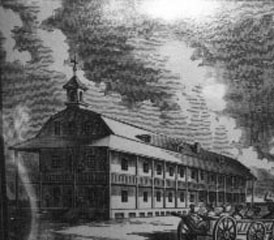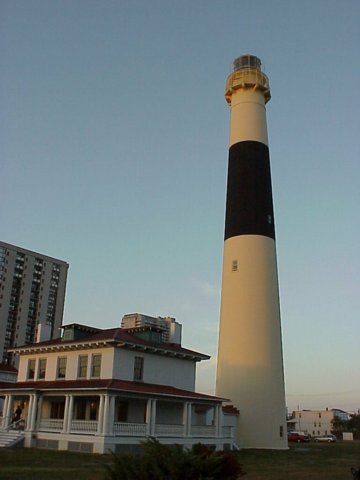


On 16 April 1854, the packet ship Powhatan sank off the coast of New Jersey in a severe storm. (This was less than five months after Herman Joseph Meiring had arrived in America on this ship.) The passengers, who were primarily German immigrants, all perished. The loss of life was estimated by various sources to be between 250 and 311 people.
The wooden schooner, a 600-ton vessel, had been built in 1839 in Baltimore. It had left Havre, France in early March 1854, under the command of Captain James Meyers of Baltimore, with a crew of about 25. Their destination was New York City.
Nearing the end of its journey, the Powhatan encountered a hurricane-like snowstorm near Long Beach Island, New Jersey. The storm was one of the worst in the state's history, and the crew struggled against the powerful and dangerous currents. On the morning of the 16th, the ship was forced closer to the island and hit the Barnegat Shoals, just 100 yards offshore from present-day Surf City.
Because of the weather, a lifeboat station six miles away was unable to send help. As word spread, a small crowd gathered on shore. Throughout the afternoon the Powhatan was pummeled by huge waves and fierce winds. Finally, the ship was slammed against the shoals around 5 p.m., and a large hole was punched in the bow. The Powhatan began to break apart, and passengers, some already dead, began to be washed overboard. Eventually the vessel broke in two. The crowd on shore searched among the bodies for signs of life, but none was found.
The state had appointed "wreckmasters" along the shoreline to deal with disasters like these. The local wreckmaster, Edward Jennings, was the manager of a large hotel nearby, called the Mansion of Health (shown in panel one). As victims slowly washed ashore, he was responsible for salvaging valuable items and accounting for the bodies until arrangements could be made.
 |
 |
 |
The victims washed onto the beach as far south as Atlantic City, where they were buried in two cemeteries. Fifty-four were interred in a mass grave at Smithville Methodist Church, and 45 were buried in Absecon. The majority of the bodies, about 140, washed ashore at Peahala on Long Beach Island. The victims and salvageable items were piled on the beach, and when the coroner arrived, he noticed that there was no money to be found on any of the bodies. This was considered unusual, since most immigrants wore money-belts containing their life savings for the voyage to America. Suspicion fell on Jennings, but he claimed innocence. These passengers were buried in pauper's graves in the Baptist cemetery in nearby Manahawkin.
Several months later, after another storm, a pile of dozens of leather money-belts was found under the stump of a cedar tree. They had been cut open, and all were empty. Jennings fled in disgrace to avoid prosecution. He was said to have been broken by his misdeeds, and was afflicted by terrible nightmares. He died in a barroom brawl in San Francisco a few years later.
Soon after the tragedy, guests at the Mansion of Health complained of hearing sobs during the night, and some caught glimpses of ghostly figures on the hotel's balcony. Rumors spread, and soon the hotel was empty. The Mansion of Health remained open for a year, but then was shuttered and closed. The building became known as the "Haunted Mansion."
In the summer of 1861, a group of five young men were attempting to stay overnight in the building, but they were frightened away by an apparition of a young woman holding a small child, standing on the balcony and gazing sadly out to sea. The woman occasionally appeared in the windows of the Mansion for some years afterward. The building burned down in 1874, and after that, accounts of the hauntings dwindled.
The State of New Jersey erected a monument to the memory of the lost passengers in the Manahawkin cemetery in 1904. It is shown in panel two.
Many shipwrecks had occurred in the area before this, with 64 occurring between 1847 and 1856. As a result, Absecon Beach had come to be called the "Graveyard Inlet." However, it was the Powhatan tragedy that caused action to be taken. Congress authorized the building of a lighthouse on Absecon Inlet at Atlantic City to warn ships of the danger. The land, which is now at Rhode Island and Pacific Avenues, was purchased in December 1854, and work began in 1856. The lamps were first lit on 15 January 1857. Its fixed light, 167 feet above the base, could be seen up to 20 miles out to sea.
In its first ten months of operation, the lighthouse proved its worth: not a single ship was wrecked. The lighthouse was operated until July 1933, and was sold by the city of Atlantic City to the state in 1966. It is shown in panel three.
| Index | Sources |